
20,000 Skeletons Found in the Vaults of a London Landmark
Hidden beneath the bustling halls of the Museum of London lies a remarkable collection that remains unseen by many visitors. Deep within the bunker-like chambers, thousands of bones from the city’s deceased are carefully preserved. Some of these centuries-old remains are not only a fascinating glimpse into history but also contribute to advancements in modern medicine. While visitors admire the exhibits above, few are aware of the intriguing and unique collection that resides beneath their feet
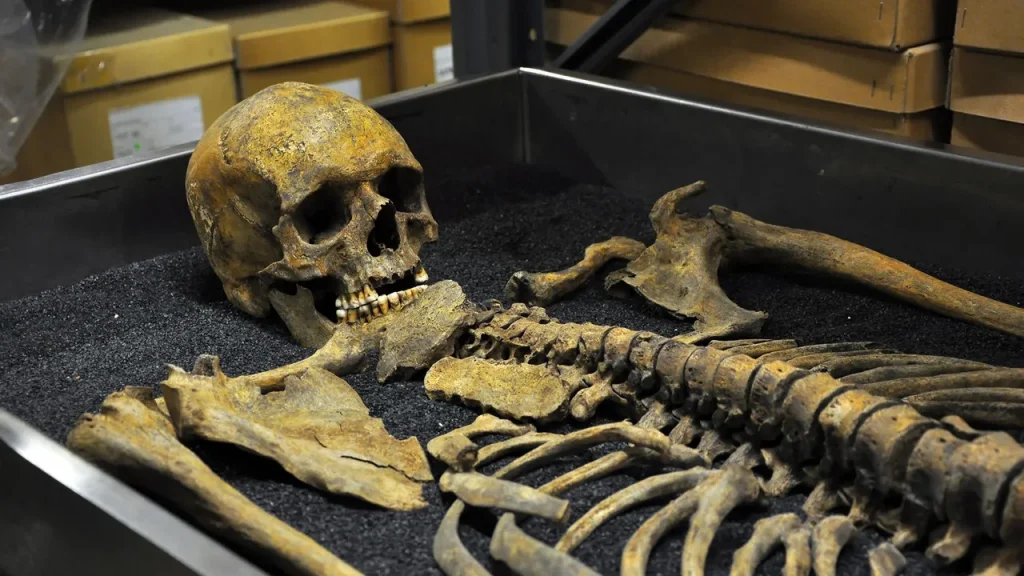
In a concrete-walled building off limits to the public, a storage facility holds shelf after shelf of cardboard boxes. They’re the sort you’d use to pack up your home for a move. But the neatly handwritten labels are all inscribed with the same words – “human skeleton” – followed by various serial numbers. Occasionally, they read “human infant skeleton”.
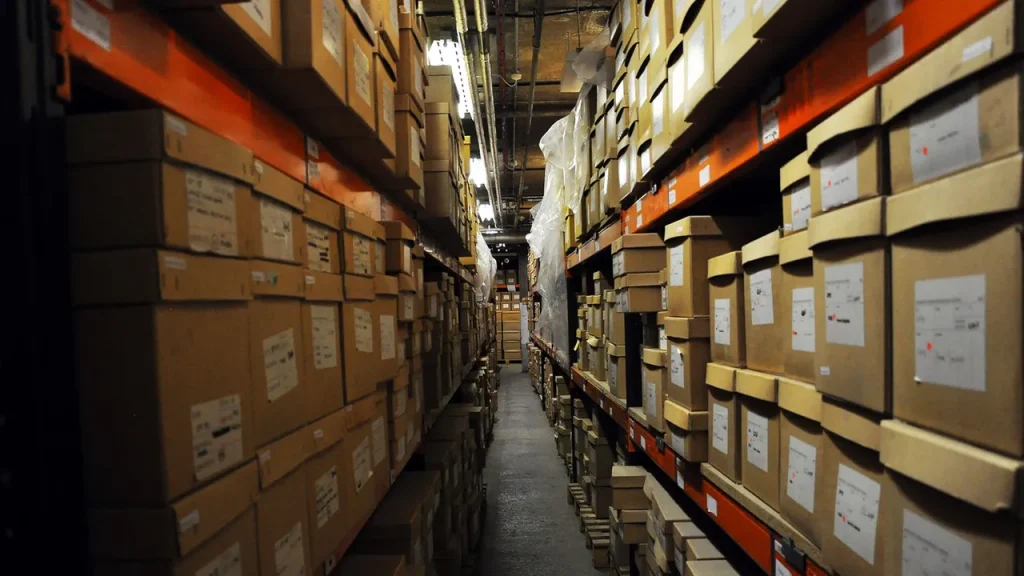
Beneath the Museum of London, a warehouse holds shelf after shelf of boxes – each one filled with human bones (Credit: Amanda Ruggeri)
This is the warehouse for the museum’s Centre for Human Bioarchaeology, home to some 20,000 human remains. “It’s probably the largest single collection of stratified human remains anywhere in the world in one city,” says Jelena Bekvalac, the centre’s curator of human osteology.
Because the skeletons date from nearly every point in London’s history – from the Roman era up to the mid-19th Century – they have taught archaeologists and historians a great deal about London’s past.
They’ve even helped re-write some of history’s most enduring stereotypes, from the idea that the city fell apart in the face of the Black Death (in fact, excavations have shown burials of plague victims were organised, neat and in consecrated ground) or that dental hygiene was terrible until the modern era (instead, the healthiest teeth come from the medieval era – courtesy of a lack of refined sugar).
But with the help of a new project, the bones may also teach us a great deal about modern human health.
Led by Bekvalac, researchers are using the skeletons to understand how industrialisation affected the health of Londoners – and how it might continue to do so in the future.
Cemetery city
It’s a broad question that can only be answered with an equally broad sample size, like the kind at the centre. “The scope is a really important thing,” says osteologist Elizabeth Craig-Atkins of the University of Sheffield, who is not involved in the project. “The dataset we have of human skeletal remains, particularly in London, is very large and has grown in past decades. This is what enables this study to be possible now.”
In many ways, it makes sense that a collection of this breadth would be in London. After all, thousands of people have been buried in the city over the centuries. Equally important, though, is that many of these remains have been unearthed by London’s ongoing development. Each time a building is constructed or a railway built, excavations must be carried out to ensure nothing crucial will be damaged, or at least to preserve artefacts and information from the site before it is. (Find out more about how London’s train lines have turned up human remains in this recent story from BBC Autos.)
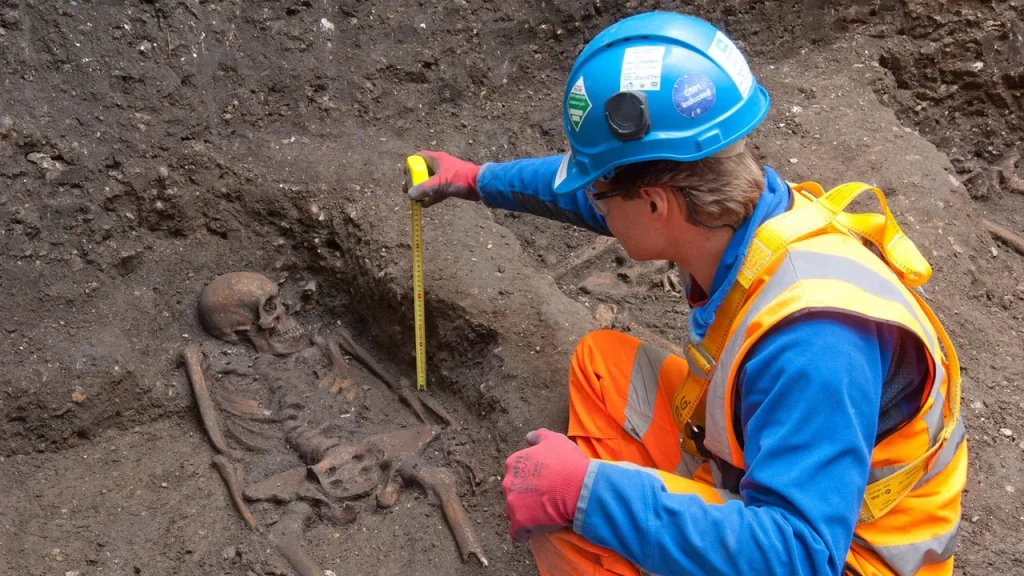
An archaeologist measures the depth of a human skeleton, one of 25 that were found during excavations for London’s Crossrail line at Farringdon (Credit: Amer Ghazzal/Alamy)
It doesn’t particularly matter if what’s being built on is an old burial site or not. In fact, says the museum’s head of archaeology Roy Stephenson, it’s often the churches themselves selling off their burial grounds.
“They had a huge programme of school upgrades at the end of the last government, and quite often schools in London are associated with churches – so time and time again, you’re expanding the size of the schools at the expense of the burial ground adjacent to them,” he says.
“It’s often the playground,” adds Bekvalac, leaving all of us with a vision – apparently accurate – of children playing hopscotch and tag over human remains. (That was the recent case at Bethnal Green, where a 2011 excavation turned up 959 skeletons beneath the playground of a Church of England primary school.)
We’ve got hair and fingernails, because sometimes you’ll get a weird burial environment where you lose all the soft tissue, but have a full, lovely head of hair – Jelena Bekvalac
Sometimes, the remains will get reburied. One reason is if they’re only a small portion of the full skeleton. That can happen not only from the site being disturbed by development over time, but even as a result of the excavation itself: archaeologists get a specified perimeter for an excavation, so they have to stop digging at exactly that border… even if it means severing a skeleton in half.
Reburial will also happen if the remains still have what Stephenson calls “squishy” or “liquidy” bits, which the Human Tissue Act prevents archaeological centres like this one from handling.
But in a burial-rich city like London, that still leaves an enormous number of skeletons that can be treated as archaeological finds. And those found within the City of London – the historic heart of the modern metropolis – tend to be left to the Museum of London’s care.
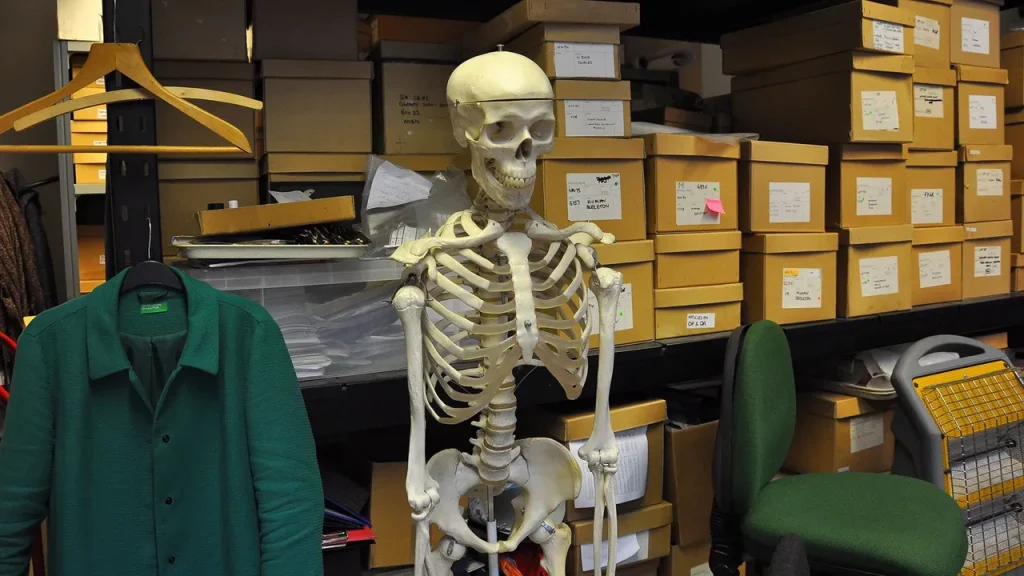
In the office of the Museum of London’s osteology department, boxes of human skeletons line the shelves (Credit: Amanda Ruggeri)
Despite the tissue ban, the centre doesn’t only hold bones. “We’ve got hair and fingernails, because sometimes you’ll get a weird burial environment where you lose all the soft tissue, but have a full, lovely head of hair,” Bekvalac says. “We’ve got some fingernails – which are nicely manicured. Then we’ve got hair from a graveyard, but no body. It’s just a plait. That’s really early medieval.”
Body of research
All of which results in the opportunity for research projects like this one. In the project, which is expected to finish in 2018, researchers are analysing 1,500 individuals from the London collection and comparing them to another 1,000 skeletons from areas outside London. One thousand of the individuals lived before the Industrial Revolution; the rest date to the 18th and 19th Centuries.
And because the researchers are using the same clinical techniques that modern-day doctors would use, namely digital radiography and CT scanning, they can also compare their finds to medical data right up to the present day.

Bones are laid out to be x-rayed at the Museum of London (Credit: Amanda Ruggeri)
Modern life has had an enormous impact on our health. What’s less clear is exactly how. In Britain, the Industrial Revolution was followed by better sanitation, free health care and a longer life expectancy. But it also meant more cases of health problems like obesity and diabetes, as well as an increase in other factors, like environmental pollutants, thought to affect health.
One way to pinpoint industrialisation’s effects, of course, is to look at human health before and after.
With a glance at a femur or finger-bone, osteologists can make a variety of diagnoses for a long-dead patient
But it’s often hard to do so. One type of evidence comes from the notes and records kept by physicians of the time. But since much of both the vocabulary and the understanding of diseases have evolved, determining what the medical problem was – at least in modern terms – can be difficult.
Then there are bones.
With a glance at a femur or finger-bone, osteologists can make a variety of diagnoses for a long-dead patient. A lobulated, raised area might indicate a varicose ulcer; frilled edges to vertebrae show joint degeneration; shine on a bone, osteoarthritis (the shine is from the bones rubbing).
On a visit to the storeroom, Bekvalac demonstrated just how much skeletons can tell us. The curator, who wears a skull-patterned bracelet and has a penchant for referring to the skeletons as “lovely” – as in “we’ve got a lovely chap over there called Nicholas Adams, who has a lovely head of hair” – had laid out the skeleton of a man who died in 1348.

This man, a victim of the 1348 Black Death, has green stains on his pelvis – thanks to where he was buried (Credit: Amanda Ruggeri)
He was buried at the East Smithfield, a site which Museum of London archaeologists excavated in the 1980s. From the context, archaeologists could make a straightforward guess as to how he died: they knew it was a medieval cemetery, and historical records showed that the Bishop of London, hearing of the Black Death on continental Europe, had pre-emptively purchased and set aside the land as an emergency burial ground.
When the plague hit, as he knew it would, 2,400 Black Death victims were buried there – including this one. (DNA tests done in 2011 later confirmed that, indeed, these individuals carried the bacteria that causes plague.)
But even if it was what killed him, the bubonic plague wasn’t his only problem.
“You see, he’s got striations here,” Bekvalac said, running her finger over the shin bone. “You’ve got an area over your bone called the periosteum. If that gets infected or inflamed, it reacts, and then you’ve got this pitted texture. If it’s like that, we know it’s healed: you had the infection, then healed. But if that was grey and finely woven, it would tell us that it was active at the time you died.”
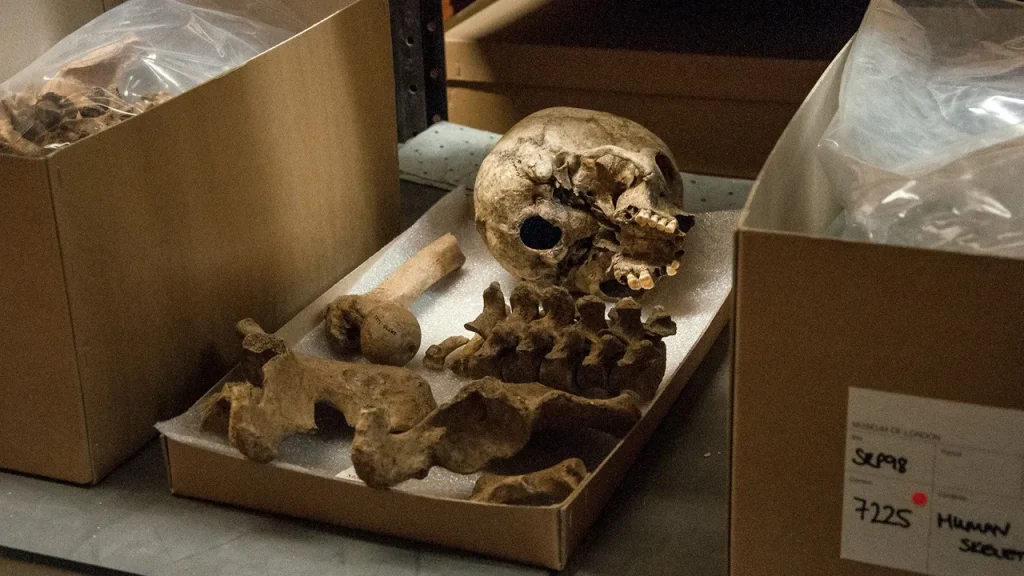
Unpacked from its box, a skeleton waits to be x-rayed (Credit: Amanda Ruggeri)
Still, there are limitations to looking with the naked eye. One challenge is that what’s seen on a skeleton might result from what happened after burial, not before.
There’s nothing quite as unpleasant as a human skeleton soaked in diesel – Roy Stephenson
Some of these are obvious – and somewhat surreal to see. The skeleton in front of us, for example, has green stains across his pelvis. In some cases, that might be because the person was buried with a copper shroud pin or a belt buckle, staining the bones after death, Bekvalac explains. But in this case, it’s because the Royal Mint operated on top of the burial site in the 19th Century. “When they spewed out the waste of the coinage, it turned all the skeletons green,” Bekvalac says. “So they’ll pick up things. Sometimes we get diesel, and petrol, and all kinds of horrible things.”
“There’s nothing quite as unpleasant as a human skeleton soaked in diesel. I remember it from Newcastle Blackfriars. Very smelly,” Stephenson adds, referring to excavations done at Newcastle’s 13th-century Dominican friary.
Then there’s tar, as was demonstrated by the Bethnal Green skeletons. One of the drawbacks, it turns out, of paving a school playground over a former burial ground is that the remains beneath are, literally, tarred.
Of course, it’s pretty easy to tell a copper stain from a pathogen. What can be more difficult is finding just exactly what those pathogens are.
Modern medicine
“What we see when we’re doing our analysis are things that are gross – something that’s affected you for a long time, or an injury like a fracture. If you have something that’s acute and fast-acting, if it’s going to kill you, we can’t see it in you. We know you’ve died of something but we don’t know what it is,” Bekvalac says. “There may also be other things that could be going on inside you that just haven’t manifested externally for us to see.”
That’s why more recent medical innovations have been so helpful. DNA analysis has provided a whole new set of data – enabling researchers to confirm, for example, that the Yersinia pestis bacteria, which causes the bubonic plague, was in fact present in the East Smithfield skeletons.
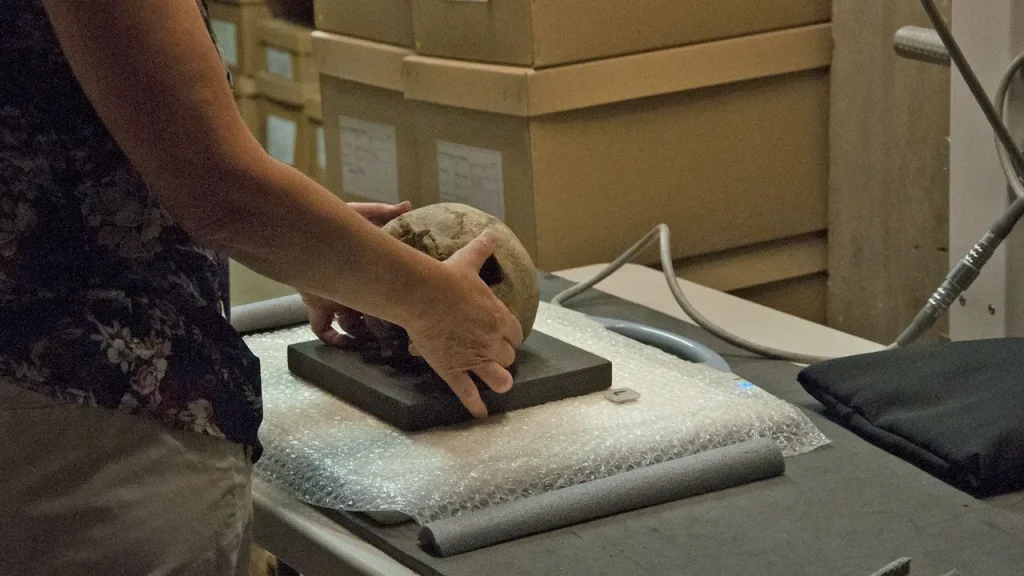
The team’s radiographer carefully arranges a human skull for its x-ray (Credit: Amanda Ruggeri)
For this project, the team has hired a professional clinical radiographer; they’re using x-ray and CT imaging to help diagnose those diseases thought to be a result of modern living, including neoplastic disease, osteoporosis and hyperostosis frontalis interna (HFI).
On another visit, I watch the radiographer carefully arrange the bones of a skeleton onto a plate. We step out of the room as she runs the x-ray.
When we re-enter, a skull has appeared on the computer screen. Like the remains of all the other individuals examined for this study, it will ultimately be saved onto a single database, one accessible to any researcher – whether archaeologist or medical student, whether someone interested in the past or the present.
There on the screen, scanned with all the precision of modern medical technology, the skull provides no clue as to whether it belongs to someone who lived until recently – or died 500 years ago.




